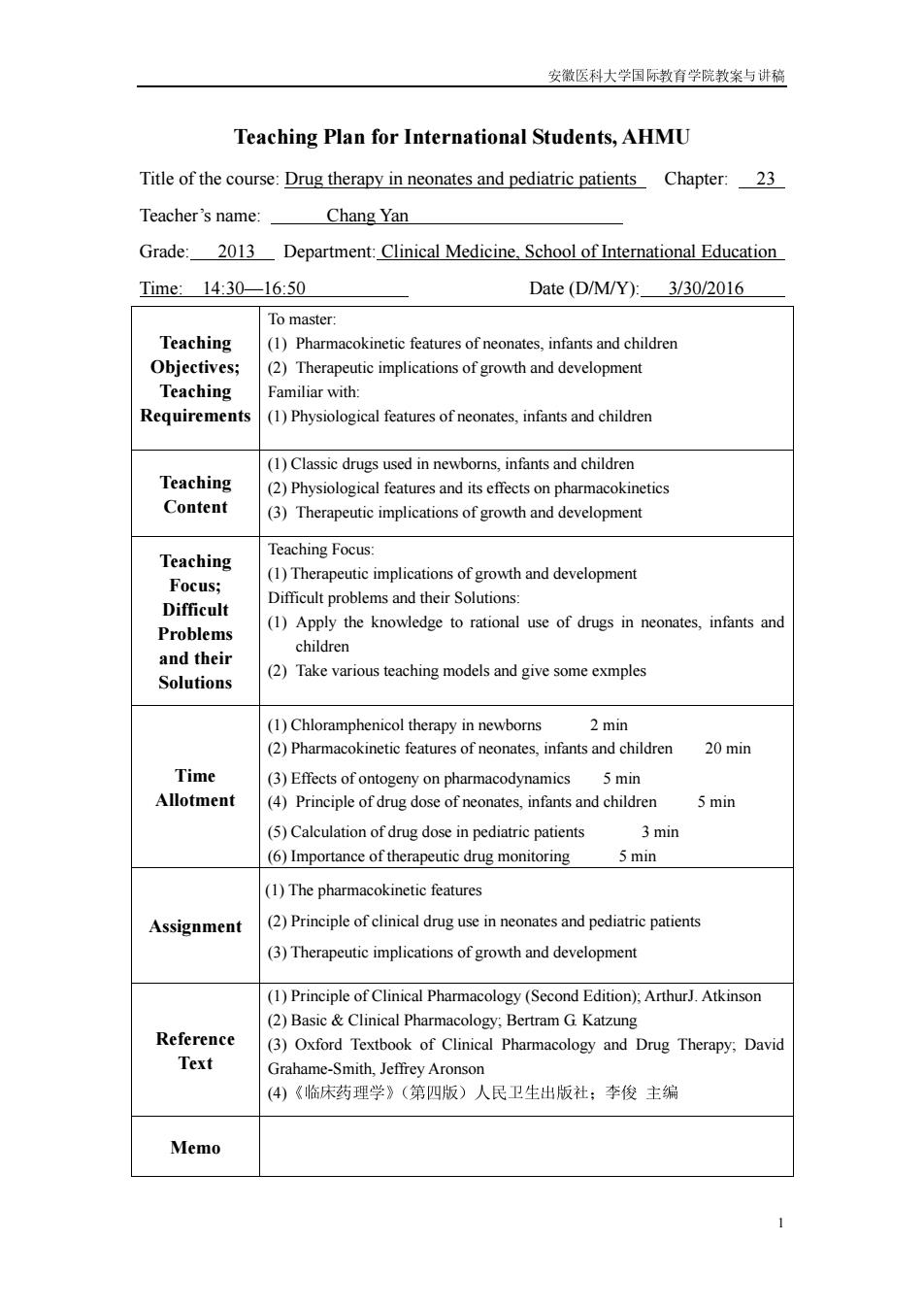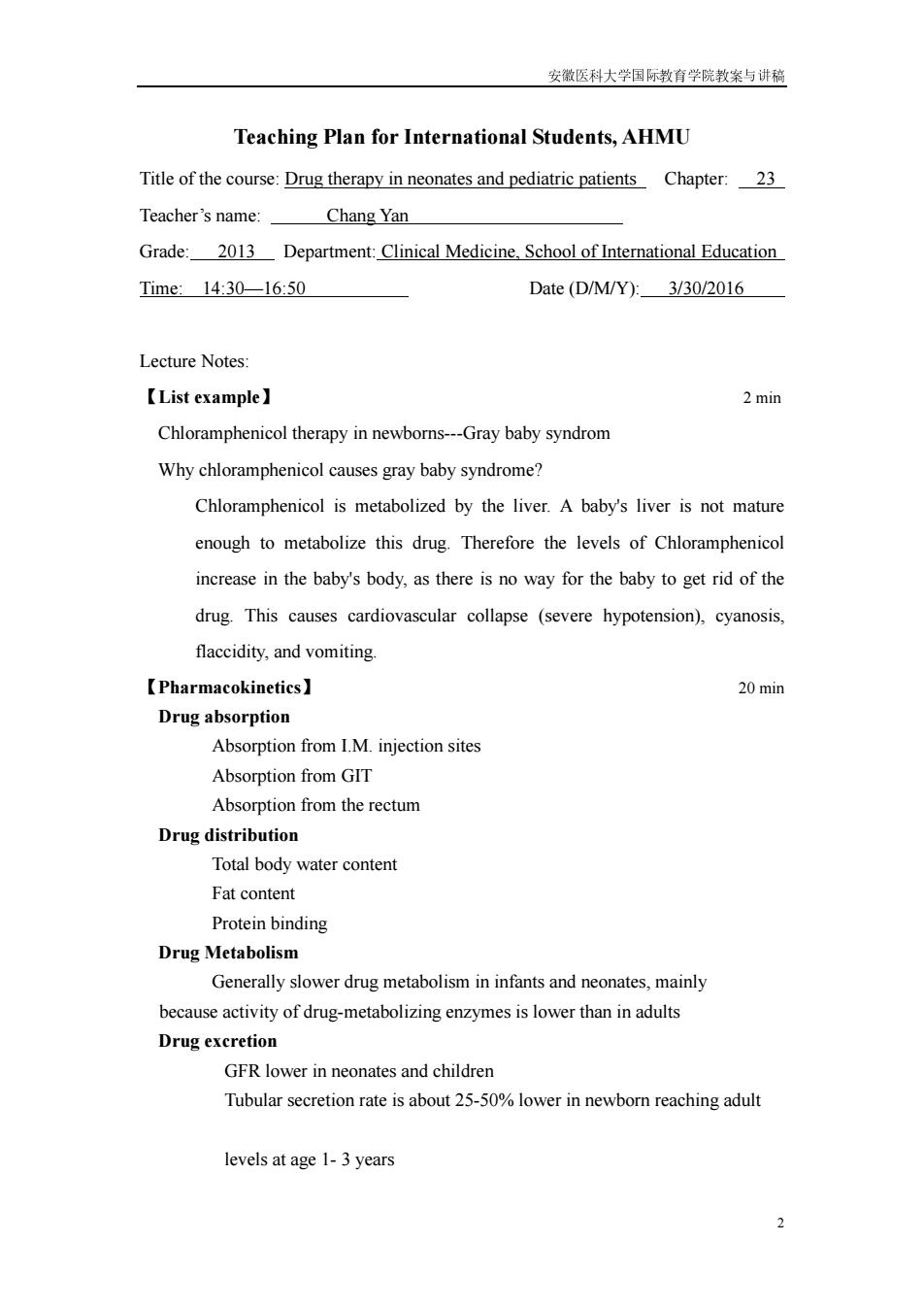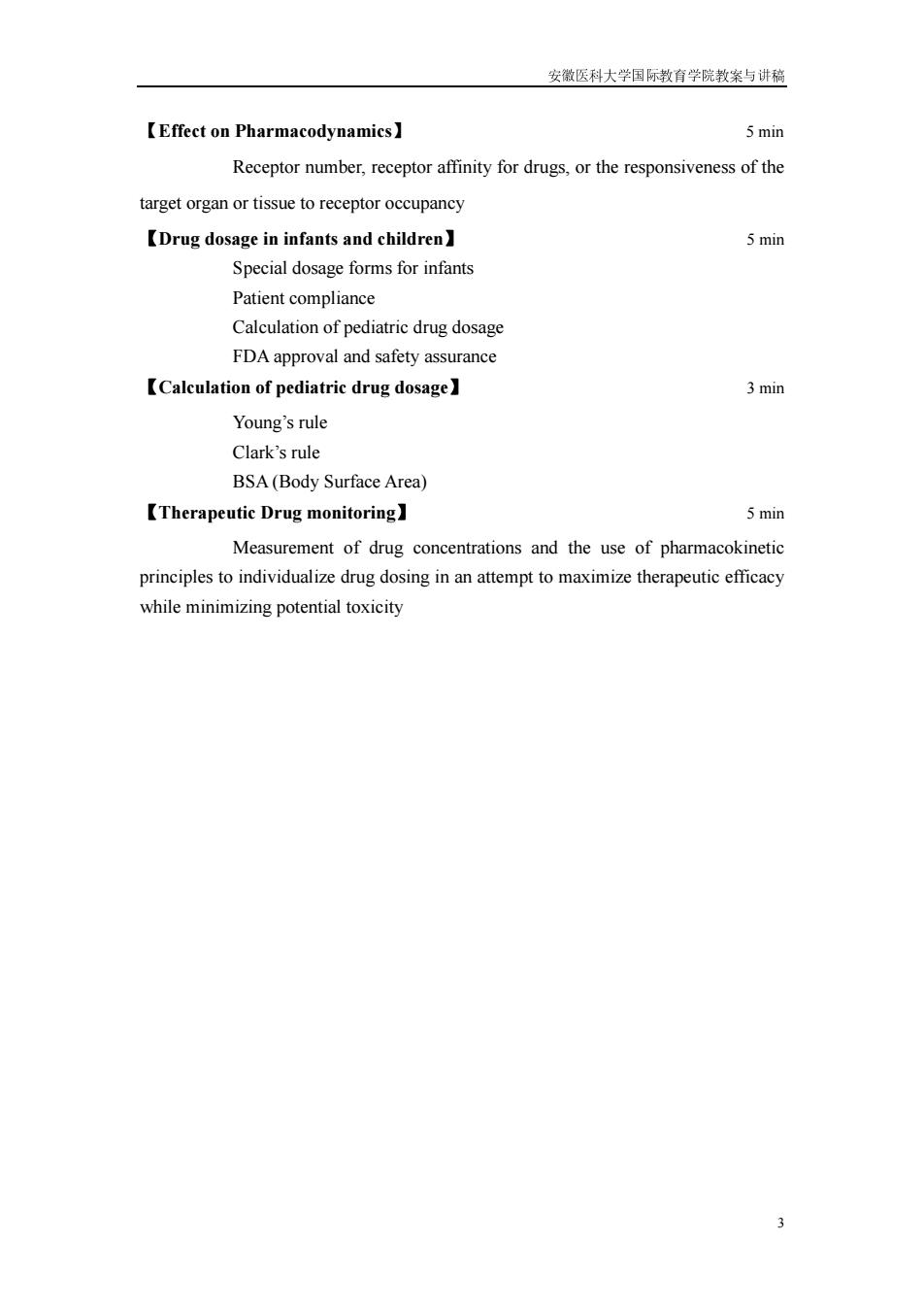
安徽医科大学国际教育学院教案与讲稿 Teaching Plan for International Students,AHMU Title of the course:Drug therapy in neonates and pediatric patients Chapter:23 Teacher's name: Chang Yan Grade:2013 Department:Clinical Medicine,School of International Education Time:14:30-16:50 Date(D/M/Y):3/30/2016 To master: Teaching (1)Pharmacokinetic features of neonates,infants and children Objectives; (2)Therapeutic implications of growth and development Teaching Familiar with: Requirements (1)Physiological features of neonates,infants and children (1)Classic drugs used in newborns,infants and children Teaching (2)Physiological features and its effects on pharmacokinetics Content (3)Therapeutic implications of growth and development Teaching Teaching Focus: Focus; (1)Therapeutic implications of growth and development Difficult Difficult problems and their Solutions: Problems (1)Apply the knowledge to rational use of drugs in neonates,infants and children and their Solutions (2)Take various teaching models and give some exmples (1)Chloramphenicol therapy in newborns 2 min (2)Pharmacokinetic features of neonates,infants and children 20 min Time (3)Effects of ontogeny on pharmacodynamics 5 min Allotment (4)Principle of drug dose of neonates,infants and children 5min (5)Calculation of drug dose in pediatric patients 3min (6)Importance of therapeutic drug monitoring 5min (1)The pharmacokinetic features Assignment (2)Principle of clinical drug use in neonates and pediatric patients (3)Therapeutic implications of growth and development (1)Principle of Clinical Pharmacology(Second Edition);ArthurJ.Atkinson (2)Basic Clinical Pharmacology;Bertram G Katzung Reference (3)Oxford Textbook of Clinical Pharmacology and Drug Therapy;David Text Grahame-Smith,Jeffrey Aronson (4)《临床药理学》(第四版)人民卫生出版社;李俊主编 Memo
安徽医科大学国际教育学院教案与讲稿 1 Teaching Plan for International Students, AHMU Title of the course: Drug therapy in neonates and pediatric patients Chapter: 23 Teacher’s name: Chang Yan Grade: 2013 Department: Clinical Medicine, School of International Education Time: 14:30—16:50 Date (D/M/Y): 3/30/2016 Teaching Objectives; Teaching Requirements To master: (1) Pharmacokinetic features of neonates, infants and children (2) Therapeutic implications of growth and development Familiar with: (1) Physiological features of neonates, infants and children Teaching Content (1) Classic drugs used in newborns, infants and children (2) Physiological features and its effects on pharmacokinetics (3) Therapeutic implications of growth and development Teaching Focus; Difficult Problems and their Solutions Teaching Focus: (1) Therapeutic implications of growth and development Difficult problems and their Solutions: (1) Apply the knowledge to rational use of drugs in neonates, infants and children (2) Take various teaching models and give some exmples Time Allotment (1) Chloramphenicol therapy in newborns 2 min (2) Pharmacokinetic features of neonates, infants and children 20 min (3) Effects of ontogeny on pharmacodynamics 5 min (4) Principle of drug dose of neonates, infants and children 5 min (5) Calculation of drug dose in pediatric patients 3 min (6) Importance of therapeutic drug monitoring 5 min Assignment (1) The pharmacokinetic features (2) Principle of clinical drug use in neonates and pediatric patients (3) Therapeutic implications of growth and development Reference Text (1) Principle of Clinical Pharmacology (Second Edition); ArthurJ. Atkinson (2) Basic & Clinical Pharmacology; Bertram G. Katzung (3) Oxford Textbook of Clinical Pharmacology and Drug Therapy; David Grahame-Smith, Jeffrey Aronson (4)《临床药理学》(第四版)人民卫生出版社;李俊 主编 Memo

安徽医科大学国际教育学院教案与讲稿 Teaching Plan for International Students,AHMU Title of the course:Drug therapy in neonates and pediatric patients Chapter:23 Teacher's name: Chang Yan Grade:2013 Department:Clinical Medicine,School of International Education Time:14:30-16:50 Date(D/M/Y):3/30/2016 Lecture Notes: 【List example】 2min Chloramphenicol therapy in newborns---Gray baby syndrom Why chloramphenicol causes gray baby syndrome? Chloramphenicol is metabolized by the liver.A baby's liver is not mature enough to metabolize this drug.Therefore the levels of Chloramphenicol increase in the baby's body,as there is no way for the baby to get rid of the drug.This causes cardiovascular collapse (severe hypotension),cyanosis, flaccidity,and vomiting. 【Pharmacokinetics】 20 min Drug absorption Absorption from I.M.injection sites Absorption from GIT Absorption from the rectum Drug distribution Total body water content Fat content Protein binding Drug Metabolism Generally slower drug metabolism in infants and neonates,mainly because activity of drug-metabolizing enzymes is lower than in adults Drug excretion GFR lower in neonates and children Tubular secretion rate is about 25-50%lower in newborn reaching adult levels at age 1-3 years 2
安徽医科大学国际教育学院教案与讲稿 2 Teaching Plan for International Students, AHMU Title of the course: Drug therapy in neonates and pediatric patients Chapter: 23 Teacher’s name: Chang Yan Grade: 2013 Department: Clinical Medicine, School of International Education Time: 14:30—16:50 Date (D/M/Y): 3/30/2016 Lecture Notes: 【List example】 2 min Chloramphenicol therapy in newborns---Gray baby syndrom Why chloramphenicol causes gray baby syndrome? Chloramphenicol is metabolized by the liver. A baby's liver is not mature enough to metabolize this drug. Therefore the levels of Chloramphenicol increase in the baby's body, as there is no way for the baby to get rid of the drug. This causes cardiovascular collapse (severe hypotension), cyanosis, flaccidity, and vomiting. 【Pharmacokinetics】 20 min Drug absorption Absorption from I.M. injection sites Absorption from GIT Absorption from the rectum Drug distribution Total body water content Fat content Protein binding Drug Metabolism Generally slower drug metabolism in infants and neonates, mainly because activity of drug-metabolizing enzymes is lower than in adults Drug excretion GFR lower in neonates and children Tubular secretion rate is about 25-50% lower in newborn reaching adult levels at age 1- 3 years

安微医科大学国际教育学院教案与讲稿 【Effect on Pharmacodynamics】 5 min Receptor number,receptor affinity for drugs,or the responsiveness of the target organ or tissue to receptor occupancy 【Drug dosage in infants and children】 5 min Special dosage forms for infants Patient compliance Calculation of pediatric drug dosage FDA approval and safety assurance 【Calculation of pediatric drug dosage)】 3 min Young's rule Clark's rule BSA(Body Surface Area) 【Therapeutic Drug monitoring】 5 min Measurement of drug concentrations and the use of pharmacokinetic principles to individualize drug dosing in an attempt to maximize therapeutic efficacy while minimizing potential toxicity 3
安徽医科大学国际教育学院教案与讲稿 3 【Effect on Pharmacodynamics】 5 min Receptor number, receptor affinity for drugs, or the responsiveness of the target organ or tissue to receptor occupancy 【Drug dosage in infants and children】 5 min Special dosage forms for infants Patient compliance Calculation of pediatric drug dosage FDA approval and safety assurance 【Calculation of pediatric drug dosage】 3 min Young’s rule Clark’s rule BSA (Body Surface Area) 【Therapeutic Drug monitoring】 5 min Measurement of drug concentrations and the use of pharmacokinetic principles to individualize drug dosing in an attempt to maximize therapeutic efficacy while minimizing potential toxicity